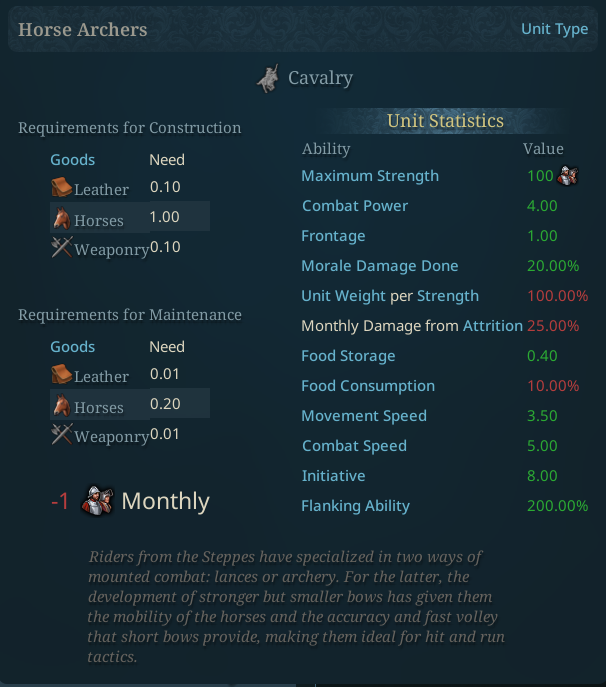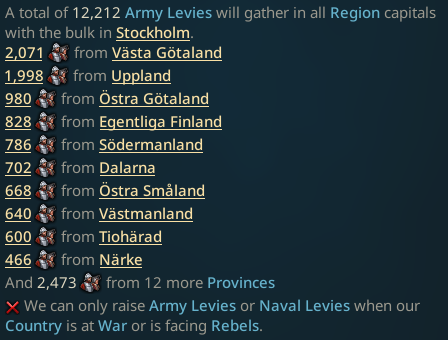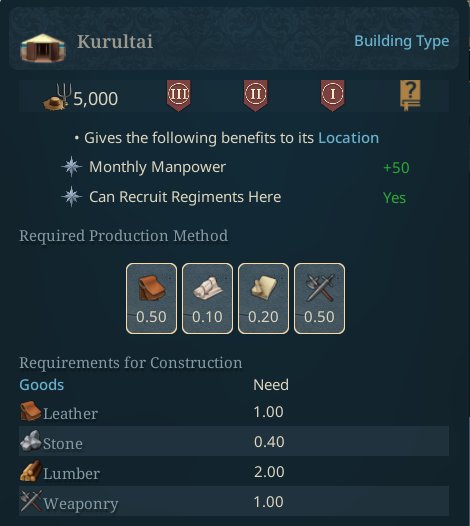Welcome to another Tinto Talks, and now we are up to the eleventh of these about this super secret game! This time we talk about military matters, and the differences between levies, mercenaries, and regular regiments.
But first..
Today, we at Paradox Tinto are releasing our Winds of Change expansion for EU4! Check out the video my team made at
And if the launch goes well, I can ask the team to start the map feedback posts later this week!
Military Organization
While there is a very large number of different types of units, they all belong to one of four different categories: Infantry, Cavalry, Artillery, or Auxiliary. Infantry is usually the bulk of most armies, and the other categories have specific roles in a campaign.
The size of a regiment varies over time, with the earliest Infantry Regiments using 100 men, while at the end of the game, there are around 3,200 men in each infantry regiment. Cavalry, Artillery, and Auxiliary units have different sizes.
We also categorize a regiment as either a levy, a mercenary, or a regular regiment. Any army can freely rearrange those into any stack they want, and split up their regiments as the player sees fit. So if you want to have half of a mercenary company in one army and the other in another army, then that is perfectly fine in this game.

This is a unique cavalry unit from the first age that some cultures have access to.
Levies
First of all, we have levies, where you can raise your able-bodied fighting men into a fighting force. This provides you with a lot of people who can fight for you, but the levies have a few slight drawbacks. First of all, you can only raise them when you are at war or facing rebels. Secondly, when you raise your levies those pops you raise them from are decreased in size to represent the pops going off to war, and any dead men in a levy is population permanently lost.. Speaking of that, levies do not spawn with any experience to speak of, and you have no direct control over the type of units you get. Another slight drawback is that levies do not reinforce during a campaign either. A province where the levies have been raised will also produce less food and raw materials.
You can either raise all your levies, or from any province individually.

Raising all able-bodied men in the Kingdom of Sweden will get us 12,000 men!
Mercenaries
There are many mercenary companies available in the world, and each area has at least a few possible to recruit. However, these are not endless free manpower, as other nations may be recruiting them before you can. A Mercenary Company signs up for at least a 2-year contract, but you can extend the contract if you so desire. More on how mercenaries can be recruited in a later talk.
Regular Regiments
Your regular army consists of the regiments that you do not want to disband and they require manpower to recruit. This recruitment can not be done everywhere though, as you need special buildings to allow recruitment of military units. Usually, these are the same type of buildings that also provide you with manpower. As the ages go by, you go from only some special buildings providing a minuscule amount of manpower to being able to build Conscription Centers in your core culture locations.
Manpower
Speaking of manpower, in Project Caesar this is primarily generated by buildings. Now you may ask, why do we need manpower when we have pops? Well, for us, manpower represents the more or less semi-trained men that can be used in a military force. And what is important, whenever a regiment loses strength, be it from attrition or combat, you will lose pops as well.

This is a unique building for Mongol steppe hordes.
One other aspect to take into account when it comes to manpower is that Project Caesar does not have force limits, but instead, you are limited by how many regiments you can maintain. Every regiment requires some manpower each month to maintain the current level of troops.
It also requires a fair amount of goods each month, and if it does not have access to it, morale will drop, and it will not be able to reinforce or maintain its current strength.
As you may have noticed in some of the screenshots above, units do have a fair bit of unique attributes. There are some common ones for your entire country.
There is also the Army Tradition, which is gained primarily from the average experience of your armies, which can be increased by drilling them, and impacts the morale & siege ability of your armies, while also slowly pushing you towards land on the land vs naval societal values.
This is not everything related to military, as we have a talk about the navies, a talk about logistics and a talk about our combat system planned as well.
Next week, however, we will be back with something completely different, and rather new and unique features.,
But first..
Today, we at Paradox Tinto are releasing our Winds of Change expansion for EU4! Check out the video my team made at
And if the launch goes well, I can ask the team to start the map feedback posts later this week!
Military Organization
While there is a very large number of different types of units, they all belong to one of four different categories: Infantry, Cavalry, Artillery, or Auxiliary. Infantry is usually the bulk of most armies, and the other categories have specific roles in a campaign.
The size of a regiment varies over time, with the earliest Infantry Regiments using 100 men, while at the end of the game, there are around 3,200 men in each infantry regiment. Cavalry, Artillery, and Auxiliary units have different sizes.
We also categorize a regiment as either a levy, a mercenary, or a regular regiment. Any army can freely rearrange those into any stack they want, and split up their regiments as the player sees fit. So if you want to have half of a mercenary company in one army and the other in another army, then that is perfectly fine in this game.
This is a unique cavalry unit from the first age that some cultures have access to.
Levies
First of all, we have levies, where you can raise your able-bodied fighting men into a fighting force. This provides you with a lot of people who can fight for you, but the levies have a few slight drawbacks. First of all, you can only raise them when you are at war or facing rebels. Secondly, when you raise your levies those pops you raise them from are decreased in size to represent the pops going off to war, and any dead men in a levy is population permanently lost.. Speaking of that, levies do not spawn with any experience to speak of, and you have no direct control over the type of units you get. Another slight drawback is that levies do not reinforce during a campaign either. A province where the levies have been raised will also produce less food and raw materials.
You can either raise all your levies, or from any province individually.
Raising all able-bodied men in the Kingdom of Sweden will get us 12,000 men!
Mercenaries
There are many mercenary companies available in the world, and each area has at least a few possible to recruit. However, these are not endless free manpower, as other nations may be recruiting them before you can. A Mercenary Company signs up for at least a 2-year contract, but you can extend the contract if you so desire. More on how mercenaries can be recruited in a later talk.
Regular Regiments
Your regular army consists of the regiments that you do not want to disband and they require manpower to recruit. This recruitment can not be done everywhere though, as you need special buildings to allow recruitment of military units. Usually, these are the same type of buildings that also provide you with manpower. As the ages go by, you go from only some special buildings providing a minuscule amount of manpower to being able to build Conscription Centers in your core culture locations.
Manpower
Speaking of manpower, in Project Caesar this is primarily generated by buildings. Now you may ask, why do we need manpower when we have pops? Well, for us, manpower represents the more or less semi-trained men that can be used in a military force. And what is important, whenever a regiment loses strength, be it from attrition or combat, you will lose pops as well.
This is a unique building for Mongol steppe hordes.
One other aspect to take into account when it comes to manpower is that Project Caesar does not have force limits, but instead, you are limited by how many regiments you can maintain. Every regiment requires some manpower each month to maintain the current level of troops.
It also requires a fair amount of goods each month, and if it does not have access to it, morale will drop, and it will not be able to reinforce or maintain its current strength.
As you may have noticed in some of the screenshots above, units do have a fair bit of unique attributes. There are some common ones for your entire country.
- Discipline, which impacts damage taken and damage done.
- Military Tactics, which impacts damage taken.
- Army Morale, which impacts how long your armies are willing to fight before breaking.
- Infantry, Cavalry, Artillery & Auxiliary power, which impacts damage done for that category.
There is also the Army Tradition, which is gained primarily from the average experience of your armies, which can be increased by drilling them, and impacts the morale & siege ability of your armies, while also slowly pushing you towards land on the land vs naval societal values.
This is not everything related to military, as we have a talk about the navies, a talk about logistics and a talk about our combat system planned as well.
Next week, however, we will be back with something completely different, and rather new and unique features.,


